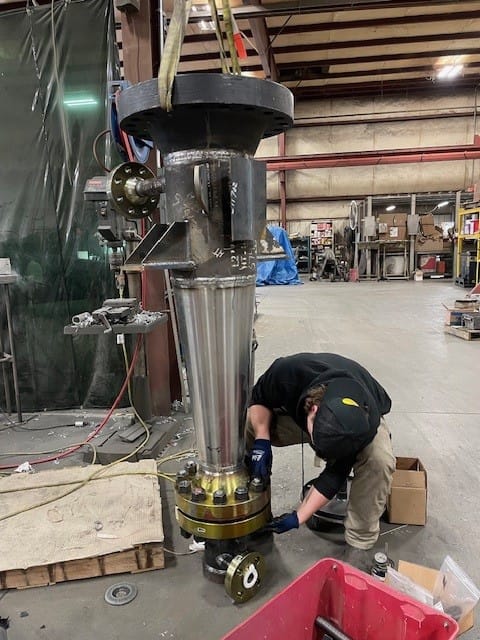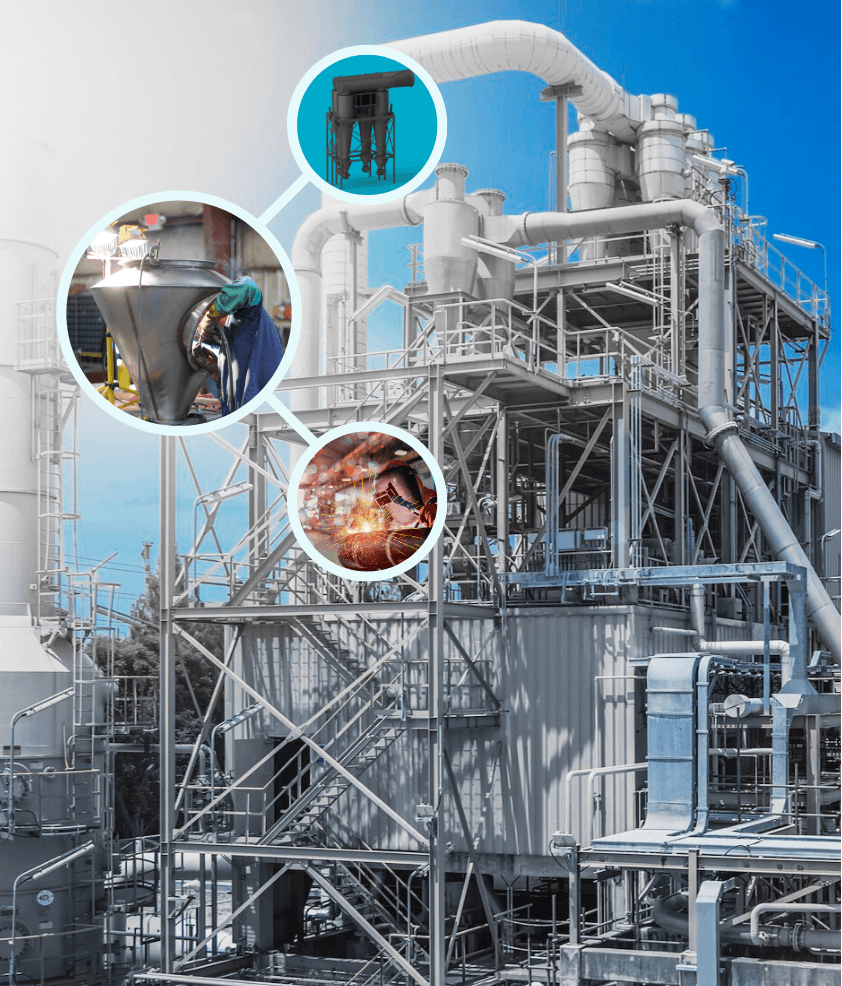
Reimagining What a Cyclone Can Do Under Pressure
Cyclones have long been a reliable solution for gas-solid separation of two-phase flow, but their use in high-pressure hydrocarbon separation, specifically for liquid-liquid applications, remains limited. In this R&D project, Heumann Environmental partnered with a client to explore whether cyclone technology could separate immiscible hydrocarbon liquids under high pressure. The result is a modular, precision-engineered system built to withstand harsh chemical conditions, manage sticky materials, and support iterative testing. This project pushes cyclone design into new territory for complex industrial separation challenges.
A quick look or a comprehensive read—Download the case study below

Comprehensive breakdown with engineering insights, materials, and technical challenges.
Quick overview of the project, key specs, and outcomes.
The Challenge
At one time or another, many now-valuable byproducts were seen as little more than waste. The challenge of separating them from the primary product has long driven innovation across industries. As demands for safer, more efficient, and environmentally responsible processes continue to grow, so does the need for novel separation technologies.
A client approached Heumann Environmental (HEC) to support a research and development initiative aimed at optimizing a hydrocarbon production process. The system produces a fluid hydrocarbon product, but also generates heavier, immiscible hydrocarbon by products with no current economic value. The goal: determine whether these secondary liquids could be selectively removed to improve product purity and overall process performance.
Although cyclones and hydroclones are not traditionally used for liquid-liquid separation, modeling suggested that meaningful hydrocarbon separation could be achieved that would be of economic significance in this process.
This was no ordinary design request. The process involved several demanding constraints:
Compounding these technical hurdles was the nature of the project itself. As an R&D effort, the system required built-in flexibility, the ability to tolerate plugging, and adaptability for testing a range of cyclone pressure drops. All of this had to be accomplished on a fast-tracked timeline, with minimal margin for error.


Solution Provided
To meet the unique performance and flexibility requirements, HEC designed a custom cyclone system and provided the detailed design to the client under license to build for the client’s internal shop, allowing them to begin immediate construction. In parallel, HEC fabricated a duplicate unit with additional design enhancements to support iterative testing and maintenance.

Key Cyclone System Features
System Specifications
Designed for Extreme Pressure Challenges
The cyclones themselves were designed, fabricated, and code stamped per ASME Boiler and Pressure Vessel Code Section VIII Division I for 1500 psig/FV at 400 °F with a 1/16th inch corrosion allowance. This robust construction ensured both performance and long-term durability for high-pressure hydrocarbon separation under this chemically aggressive testing environment.
Removable, Polished Liner for Easy Cleanout
A key feature of the HEC-built unit was the inclusion of a removable stainless steel liner, custom-machined to slide into and out of the cyclone body with precision. This liner was fabricated from thicker plate stock, allowing the outer diameter to be machined for a snug fit while maintaining a highly polished interior surface roughness (Ra) of less than 12 microinches.
This ultra-smooth internal finish helps reduce buildup from sticky process fluids and enables easy removal for cleaning, critical in a process where cooled materials can solidify and cause system blockages.
Interchangeable Outlet Pipes for Testing Pressure Drop
To study how cyclone performance varied with pressure drop, HEC provided two alternate outlet nozzles that could be swapped with the standard outlet. Because modifying the gas inlet, gas outlet, or product discharge wasn’t practical, this approach allowed the client to fine-tune the cyclone’s behavior under fixed flow conditions without altering the core vessel design.
These interchangeable components gave the client the flexibility to evaluate a range of separation scenarios and pressure drops with minimal disruption to the setup.

Results and Outcomes
Delivered on an accelerated timeline, the cyclone system has entered active testing as part of the client’s process optimization initiative. While still early in evaluation, initial results are encouraging, demonstrating potential for meaningful hydrocarbon separation under demanding conditions. Its modular configuration and interchangeable components allow for on-the-fly adjustments to pressure drop and flow dynamics, enabling a deeper understanding of how cyclone behavior can be tuned for liquid-phase hydrocarbon separation.

Innovative Cyclone Engineering for Evolving Industrial Needs
What sets this project apart is the application itself: cyclone-based liquid-liquid separation—a nontraditional use of this technology. The system was engineered specifically to explore this boundary, addressing the challenge of separating immiscible hydrocarbon liquids with different densities.
As industries seek cleaner, more efficient processes, the ability to recover value from byproducts is becoming increasingly important. While cyclones are typically used for gas-solid separation, this work highlights their potential in liquid-liquid applications, opening the door to broader use in complex fluid systems.
Ongoing testing will further define its capabilities, but the direction is clear: this is a meaningful step toward expanding cyclone technology’s role in modern processing.

Beyond Off-the-Shelf: Solutions for Tough Applications
High-pressure systems aren’t just physically demanding, they challenge the limits of design, materials, and imagination. When your process demands solutions that withstand high temperatures, endure relentless abrasion, hold intense pressure, or have specialized surface finishes, off-the-shelf equipment won’t cut it.
Explore Our High TAPS Solutions
At Heumann Environmental, we take a collaborative, custom-engineered approach to align each solution with your operational goals. Backed by decades of experience, we design high-performance systems that improve recovery, reduce emissions, and enhance sustainability, while ensuring compliance, reliability, and efficiency.
From high-pressure hydrocarbon gas streams to abrasive particulates and precision sanitary finishes, our solutions are designed for long-term durability, efficiency, and compliance across industries like oil & gas, chemical processing, and pharmaceuticals.
Learn more about our High TAPS expertise and how we engineer solutions to thrive under the toughest conditions.